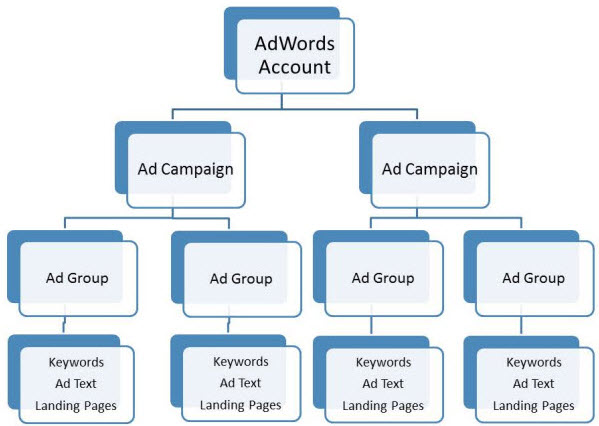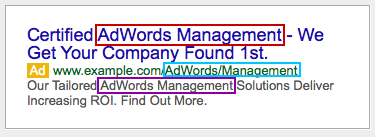I am a personal fan of the account structure in a Google Adwords account. I like the hierarchy that exists and the flexibility it provides. Over the years this has facilitated a lot of experimentation on the best way to set up accounts to achieve the best possible results for both ourselves and our clients.

AdWords Account Structure Credit: Wordstream
If you are familiar with AdWords accounts you will be familiar with this set up too. And it is probable, like me you have also tried different ways to set up your campaigns as well within the hierarchy illustrated above.
There ae many variables one can affect within an AdWords account. The number of keywords in each ad group is one of the most important. In this post we are going to look at Single Keyword Ad Groups and the reasons for an against setting them up.
What are Single Keyword Ad Groups?
Single keyword ad groups (SKAGs) as its name might suggest is an ad group in an AdWords account that has a single keyword in it. This could be constructed in a couple of ways:

For example you might have one specific keyword (in this case key phrase) in the ad group with the keyword match type you desire. Or you might include multiple keyword match types with the same ad group using different bids to allow them to trigger differently.
As AdWords has evolved and our understanding of it has increased over the years we have gravitated towards this set up. Lets consider the pros and cons of doing this:
The Pros of Single Keyword Ad Groups
- Easier to optimise your Ad for the [only] keyword in your Ad Group.
Clearly if you have a number of keywords within an Ad group you have to decide which keywords your Ad text is going to contain. But with a single keyword you can focus purely on a single term.
Lets use the example of a SKAG for the term ‘AdWords Management‘
Here’s an Ad we have ran in the passed:

See how our one and only keyword is found in the Headline Text, the Display URL and the Ad Description. So if someone is searching for ‘AdWords Management’ and they see this ad appear, they can be pretty sure their search matches our ad as it is clearly optimised for this term.
2. Better click-through rate
As the ad is optimsed for the keyword someone is searching on better click-through rates can be expected.
3. Better Quality Score
Quality score (QS) in part determines how your ad is ranked. In fact QS x bid determines where your ad will rank. One of the most important factors in determining QS is your click-through rate, so a higher clickthrough rate of ads in a SKAG will in turn have a better CTR.
3. Lower cost per click
A higher QS in turn leads to a lower cost per click.
4. Better ad position / more ad impressions
With a higher QS than a competitor your ad can show in a higher position even if you bid significantly less than they do.
5. More conversions & lower cost per conversion
If you ad is highly optimised for a single term and CTR improves due to the reasons above, the number of conversions is likely to increase and at the same time the cost per conversion will decrease.
6. Increasing return on ad spend and improving return on investment
Most importantly of all, the bottom line. If you are delivering a more engaged visitor to your website because your ad is optimised specifically to what they are searching for you are going to getter better results overall.
The Cons of Single Keyword Ad Groups
Other than it being a nickname/street name for heroin there is just one tangible reason to consider not using SKAGs.
- It takes time to set up
You may be reading this post, thinking this is all well and good, but how can you possibly do this if you have thousands of keywords in your campaigns.
Our advice to you
As always it boils down to results and the time you have available to manage your AdWords accounts. In an ideal world, it would be beneficial universally adopt SKAGs in your campaigns. However, if you have hundreds, or thousands or tens of thousands of keywords this might not be practical.
Our advice would be to identify your most important keywords. Perhaps pick 10 to start with set up SKAGs for them. Before you do, review performance to date on them in terms of the metrics that matter (QS, CTR, CPC, CPA, ROAS, as well as on site metrics like Bounce rate and time on site). After a month of running SKAGs review performance again and compare your SKAG data to the historical information you recorded for the ads you previously ran with multiple keywords in each ad group.
The expectation is you are going to see better results. If these results are significant and your bottom line is improving its time to set up some more SKAGs and reap yet further benefits.
Do you want to find out more about Single Keyword Ad Groups.? Or are you looking for another Google AdWords Management Solution? Drop us a line at SWOT Digital and we’d be happy to discuss how we can help you.
Author: Paulo









